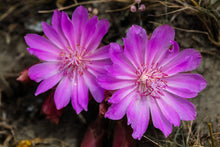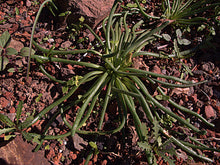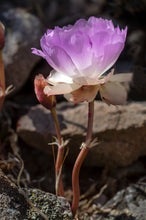
Lewisia rediviva
Bitterroot is a glorious challenge that we’re pretty sure many experienced habitat gardeners are excited to accept! This striking species emerges in winter, from a taproot snaking deep into rocky crevices, as a succulent rosette of cylindrical leaves. These leaves wither in late spring and early summer with the onset of its exquisite flowers, ranging in color from deep-rose, to pink or white, with a satin-like sheen. It makes a spectacular addition to stone walls, rock gardens and container plantings - especially those that are well-protected from too much rain and have excellent drainage.
- Plant type/canopy layer: deciduous, perennial, herbaceous plant
- Size at maturity: 0-12” tall; 0-12” wide
- Light requirements: full sun
- Moisture requirements: dry soil, requires excellent, fast-drainage
- Bloom time: April - July
- Growth rate/ease: moderate growth rate, difficult to grow
- Wildlife support: flowers attract and provide nectar to adult butterflies, bees and other insect pollinators
- Native habitat/range: can be found growing in loose gravelly soils, on rocky slopes and outcroppings and in sagebrush steppe, from just above sea level to alpine, east of the Cascade crest, from British Columbia to northern California - and even eastward into Montana, Wyoming, Utah and Colorado. Portland Plant List - no.
- Special features & uses: highly drought-tolerant; landscape uses include rock walls, rock gardens, container gardening (clay/earthen pots)
Gardening with Bitterroot: Plant this show-stopper with full knowledge that can be very difficult to maintain if you live west of the Cascade crest. This dry-adapted species requires full sunlight with thin, exceptionally well-drained soil. If you're in Western Oregon or Washington, locations with at least some protection from winter rains are ideal. Perhaps your best option is a clay pot or trough located in a dry location. Excellent companion plant options include other herbaceous species such as native Allium sp, blue-eyed grass (Sisyrinchium bellum), Brodiaea sp., sulphur flower buckwheat (Eriogonum umbellatum), blue flax (Linum lewisii) and California poppy (Eschscholzia californica). Never irrigate once the plant is established.
Photo Credit 1:"Lewisia rediviva on Tronsen Ridge" by brewbooks is licensed under CC BY-SA 2.0.
Photo Credit 2: "Bitterroot - Lewisia Rediviva" by YellowstoneNPS is marked with Public Domain Mark 1.0.
Photo Credit 3: "H20140313-0922—Lewisia rediviva—RPBG-1" by John Rusk is licensed under CC BY 2.0.
Photo Credit 4: "Lewisia rediviva" by John Game is licensed under CC BY 2.0.







